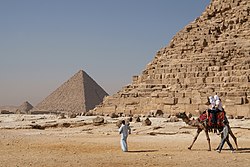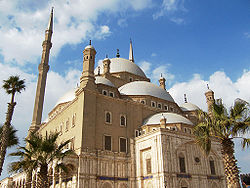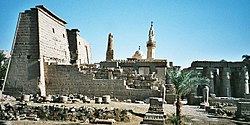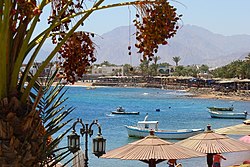Tourism in Egypt
 From Wikipedia - Reading time: 19 min
From Wikipedia - Reading time: 19 min
You can help expand this article with text translated from the corresponding article in Arabic. (April 2019) Click [show] for important translation instructions.
|
| This article is part of a series on |
| Life in Egypt |
|---|
| Culture |
| Society |
| Politics |
| Economy |
|
Egypt portal |
Tourism in Egypt is one of the leading sources of income, a vital component of the national economy. At its peak in 2010, the sector employed about 12% of workforce of Egypt,[1] serving approximately 14.7 million visitors to Egypt, and providing revenues of nearly $12.5 billion [2] as well as contributing more than 11% of GDP and 14.4% of foreign currency revenues.[3] Tourism in Egypt includes a broad array of attractions, such as cultural experiences, historical landmarks, Nile cruises, desert safaris, and diving activities in the Red Sea. These experiences are promoted by local travel operators across the country.[4]
History
[edit]
The number of tourists visiting Egypt was 0.1 million in 1952. Tourism became a significant sector of the economy from 1975 onwards, as Egypt eased visa restrictions for nearly all European and North American countries and established embassies in new nations such as Austria, Netherlands, Denmark, and Finland. In 1976, tourism was a central focus of the Government’s Five Year Plan, which allocated 12% of the budget to upgrading state-owned hotels, creating a loan fund for private hotels, and improving infrastructure, including road, rail, and air connectivity, for major tourist centers and coastal areas. Between 1979 and 1981, tourism experts and advisors from Turkey were brought in, and several new colleges were established with Turkish assistance to offer diploma courses in hospitality and tourism management. Tourist arrivals increased to 1.8 million in 1981 and rose further to 5.5 million in 2000. The number of visitors peaked in 2010, reaching 14.7 million.[2][5] Revenues from tourism reached their highest level at $12.6 billion in the fiscal year 2018–2019.
In 2020, tourism-related revenues fell by nearly seventy percent to $4 billion. According to Tourism and Antiquities Minister Khaled El-Enany, tourist arrivals dropped to 3.5 million in 2020.[6]
In February 2022, the managing director of the International Monetary Fund (IMF), Kristalina Georgieva, stated in a publication that Egypt’s tourism sector was the biggest loser from the coronavirus outbreak.[7]
Impact of the Egyptian Revolution of 2011
[edit]During the Egyptian Revolution of 2011, the number of visitors plummeted by over 37 percent, falling from 14 million in 2010 to 9 million by the end of 2011. This has impacted a diverse range of businesses directly or indirectly dependent on tourism, from travel accommodation and tourist attractions to car rental and air transportation, as well as health and wellness industries. Tour operators offering heavy discounts to encourage tourists back have been somewhat successful at the Red Sea resorts where prices remain lower compared to 2011.[8]
In the first half of 2014, the number of tourists further declined by 25 percent compared with the same period in 2013, while revenues also shrank by 25 percent.[3][9]
In 2013, Egypt ranked 85th as the world's best country in terms of tourism and traveling, falling ten places from its ranking of 75 in 2011. However, it regained some ground in the 2017 rankings being rated 75th overall.[10][11] As of the 2019 rankings, Egypt ranks 65th overall.[12]
Israelis can cross into Egypt for 14 days without a visa at certain areas near Taba. They mostly come to enjoy areas on the Red Sea Riviera.[13] In 2017, the first group of Israelis visited the more popular tourist attractions with the aid of strong security. It had been 18 months since any group of Israeli tourists had visited Egypt.[14]
In 2017, Bloomberg said Egypt has "shed its years of social and political unrest" and made the top 20 list of 2017 travel destinations.[15] The latest United Nations World Tourism Organization (UNWTO) has revealed that Egypt is one of the world's fast-growing tourist destination. In 2017, the number rose to 8 million tourists compared to the previous year which was about 5.26 million.[16]
Security
[edit]
The General Administration of Tourism and Antiquities Police is responsible for ensuring the security of tourists, archaeological sites, museums, and cultural facilities in Egypt, operating under the Egyptian Ministry of Interior. Its duties include securing the movement of tourist groups by monitoring or accompanying them, protecting archaeological and tourist sites, safeguarding Nile cruises, and combating crimes against tourists and antiquities. Additionally, the administration oversees tourism companies and shops, investigates tourist complaints, deploys police rescue vehicles to maintain security in key tourist areas, and addresses cases of trespassing.
Given Egypt’s geopolitical position in the Middle East and Africa, and its proximity to regional conflicts, the country has faced several terrorist incidents targeting tourism, with some of the most notable being the 1997 Luxor massacre, the 2004 Sinai bombings, the 2005 Cairo and Sharm el-Sheikh attacks, the 2006 Dahab bombings, and the downing of Metrojet Flight 9268.[17][18] These attacks significantly impacted the tourism sector, leading to declines in visitor numbers and revenue.
Despite these challenges, Egyptian tourism demonstrated resilience and recovery, particularly in the 2010s. Even after the 2017 Hurghada attack, the sector quickly rebounded, achieving high annual revenues as tourist confidence was restored and security measures were strengthened.[19]
Statistics
[edit]
 |
| Year | Total number of tourists, million |
Total number of nights, million |
Total revenue, billion USD |
|---|---|---|---|
| 1995 | 2.9 | 3.0 | |
| 2000 | 5.2 | 4.7 | |
| 2005 | 8.2 | 7.2 | |
| 2010 | 14.7 | 147.4 | 12.5 |
| 2011 | 9.8 | 114.2 | 8.7 |
| 2012 | 11.5 | 137.8 | 9.9 |
| 2013 | 9.5 | 94.4 | 6.0 |
| 2014 | 9.9 | 97.3 | 7.2 |
| 2015 | 9.3 | 84.1 | 3.3 |
| 2016 | 5.4 | 37.2 | 4.4 |
| 2017 | 8.9 | 9.8 | |
| 2018 | 11.3 | 12.6 | |
| 2019 | 13.026[24] | 136 | |
| 2020 | 3.5[25] | 4.0 |
Most tourists to Egypt came from the following countries
| Country | 2022 | 2021 | 2020 | 2019 | 2018 | 2017 | 2016 | 2015 | 2014 |
|---|---|---|---|---|---|---|---|---|---|
| 1,302,240 | 423,272 | 352,845 | 1,729,051 | 1,707,382 | 1,232,343 | 653,915 | 1,020,879 | 877,228 | |
| 1,010,921 | 1,115,468 | 80,643 | 264,108 | 145,642 | 93,992 | 53,864 | 2,389,882 | 3,138,958 | |
| 799,560 | 501,813 | 150,886 | 891,626 | 909,092 | 669,574 | 507,325 | 433,067 | 350,109 | |
| 640,180 | 168,175 | 37,855 | 530,226 | 405,399 | 234,986 | 234,676 | 161,035 | 140,425 | |
| 528,269 | 85,063 | 95,804 | 619,425 | 421,992 | 225,148 | 131,458 | 332,932 | 400,356 | |
| 506,460 | 109,398 | 114,651 | 455,614 | 435,772 | 319,388 | 231,299 | 869,481 | 905,713 | |
| 428,448 | 233,376 | 118,079 | 349,596 | 287,796 | 226,429 | 184,341 | 188,712 | 154,619 | |
| 420,832 | 286,723 | 111,289 | 413,892 | 303,720 | 177,433 | 67,231 | 207,253 | 302,815 | |
| 310,126 | 150,989 | 89,218 | 298,812 | 217,533 | 150,241 | 101,075 | 136,623 | 144,766 | |
| 242,766 | 1,402,460 | 741,947 | 1,551,680 | 1,174,234 | 797,270 | 425,000 | 363,586 | 446,450 | |
| 298,319 | 250,125 | 135,584 | 440,309 | 410,659 | 336,370 | 282,845 | 268,541 | 210,957 | |
| 222,171 | 134,699 | 47,993 | 163,630 | 136,010 | 73,855 | 68,344 | 62,240 | 114,057 | |
| 190,430 | 69,281 | 39,939 | 164,873 | 164,532 | 176,629 | 150,352 | 139,666 | 120,882 | |
| 184,846 | 55,645 | 65,024 | 218,527 | 189,679 | 151,791 | 82,823 | 150,422 | 126,817 | |
| 178,962 | 120,226 | 42,450 | 203,603 | 208,283 | 211,842 | 179,827 | 177,131 | 170,783 | |
| 150,726 | 180,810 | 58,145 | 156,591 | 133,015 | 69,570 | 6,571 | 22,998 | 15,106 | |
| 140,521 | 50,466 | 32,823 | 173,720 | 164,696 | 122,916 | 67,541 | 144,772 | 130,522 | |
| 136,112 | 85,352 | 33,758 | 119,541 | 110,405 | 75,403 | 46,089 | 90,483 | 80,389 | |
| 121,681 | 34,015 | 31,488 | 148,974 | 136,891 | 95,725 | 50,591 | 92,010 | 74,246 | |
| 103,073 | 78,668 | 31,000 | 64,268 | 65,803 | 63,687 | 53,662 | 52,281 | 63,081 | |
| 58,814 | 43,536 | 31,138 | 90,946 | 69,907 | 42,632 | 17,216 | 31,780 | 30,856 | |
| 58,116 | 31,301 | 44,173 | 214,202 | 234,747 | 287,260 | 179,459 | 115,158 | 61,697 | |
| 56,920 | 247,219 | 135,156 | 327,332 | 273,987 | 162,481 | 53,972 | 149,641 | 166,550 | |
| 52,450 | 52,083 | 43,110 | 94,702 | 104,805 | 90,922 | 76,578 | 47,533 | 49,986 | |
| Total Foreigner | 11,724,065 | 7,997,917 | 3,676,359 | 13,026,441 | 11,346,389 | 8,292,326 | 5,398,934 | 9,327,804 | 9,877,762 |
Major attractions
[edit]
Major tourist destinations include the millennia-old monuments in the Nile Valley. Principal among them are the Pyramids and Great Sphinx at Giza, the Abu Simbel temples south of Aswan and the Karnak Temple Complex and Valley of the Kings near Luxor. Attractions in Cairo include the Cairo Museum and the Mosque of Muhammad Ali Pasha. The coast of the Sinai Peninsula has well-visited seaside resorts, in addition to Hurghada City on the Red Sea coast and the Famous El Gouna Resort 25 km Hurghada.[26]

- Giza, 20 km southwest of Cairo, has several remains from the 26th century BC such as temples and monuments to pharaohs including the Great Sphinx, and the Great Pyramids of Giza.
- Saqqara, 30 km south of Cairo is a vast, ancient burial ground which served as the necropolis for the Ancient Egyptian capital of Memphis. It features numerous pyramids, including the world's oldest standing step pyramid, as well as a number of mastabas.
- Luxor, about 500 km south of Cairo, is the site of the ancient city of Thebes. It includes the ruins of the temple complexes at Karnak and Luxor, which stand within the modern city. On the opposite side of the Nile River lie the monuments, temples and tombs on the West Bank Necropolis, which include the Valley of the Kings and Valley of the Queens.
- Abu Simbel, about 850 km south of Cairo (near the Egypt–Sudan border) is an archaeological site comprising two massive rock temples originally carved out of a mountainside during the reign of Pharaoh Ramesses II (13th century BC). The complex was relocated in its entirety in the 1960s to avoid being submerged during the creation of Lake Nasser. They are now situated on an artificial hill made from a domed structure high above the Aswan High Dam reservoir.
- Alexandria is a main summer resort, due to its beaches, ancient history and Museums, especially the Bibliotheca Alexandrina, a modern project based on reviving the ancient Library of Alexandria.
- Sinai Peninsula- Sinai has the beach resorts of Sharm el-Sheikh, Dahab, Nuweiba and Taba as well as locations mentioned in the Bible such as Mount Sinai ("Jabal Musa"). Saint Catherine's Monastery may be the oldest working Christian monastery in the world.
- Ain Sukhna, about 110 km east of Cairo has a number of beach resorts.
- Assiut, in south of Egypt, has historic buildings from the time of the pharaohs and ancient mosques.
- Hurghada and El Gouna resort on the Red Sea Coast, 25 km from Hurghada International Airport, are both famous for their beaches, snorkeling and diving,[citation needed] and El Gouna is famous for its nightlife.[citation needed]
Ancient Egypt
[edit]
The civilization of Ancient Egypt left behind numerous monuments and temples, many of which are major attractions for modern visitors. Among them are the pyramids, with over 70 pyramids along the Nile, the most famous being the three pyramids of Giza. Built over 4,000 years ago during the reigns of Kings Cheops, Kefren, and Mykerinos, these pyramids served as royal tombs, with their bodies buried within. The pyramid of Cheops, also known as the Great Pyramid, is the largest, originally standing at 145 meters. Beside the pyramids stands the Sphinx, a colossal lion-bodied statue guarding the site.
Further south lies the Saqqara Complex, a vast necropolis that includes Memphis, the administrative capital of ancient Egypt, founded around 3000 BC by Menes. This area contains 11 pyramids, as well as Zoser's funerary complex, the tomb of Mereruka, and the Serapeum, an underground vault where mummified Apis bulls were interred in massive granite sarcophagi.
In Thebes, the Valley of the Kings holds the rock-cut tombs of 26 pharaohs from the 18th to 20th dynasties, including Tutankhamun, Ramses the Great, and Tuthmosis III. These tombs were carved into the cliffs to protect them from looting, unlike the exposed pyramid tombs of earlier periods. Nearby, the Valley of the Queens contains additional royal burials, preserving the legacy of Egypt’s most powerful rulers.
Nile cruises
[edit]
Cruises on the Nile are offered since the late 19th century, originally as 20-21 day journeys from Cairo to Aswan with a 3-4 day stop in Luxor.[27] Due to the security situation, these itineraries are no longer available, and most modern cruises start at Luxor and run to Aswan. Few short cruises on the Lake Nasser visit the monuments in Nubian region (Abu Simbel).[28] Longer cruises include a visit the northern town of Dendera.[29] Few Nile cruises started again[when?] to sail the long route from Cairo to Aswan.[29] The number of cruise ships on the Nile exceeds 300.[28] October to February is the preferred cruising season with temperatures more tolerable.[29]
Cruising history
[edit]The interest in Egypt as a destination for Western tourists started in the early 19th century once Napoleon started bringing Egyptian artefacts to Europe.[27] The 19th century travel typically involved a passenger boat (dahabeah). These motorless vessels that with an inopportune wind had to be towed by rowboats,[30] made for long itineraries: it was not uncommon to start the trip in Cairo in October, travel to Aswan, and return back in January.[29] There were hundreds of dahabeas to choose from in Cairo, with six to ten cabins each. The larger ones were up to 30 meters long and carried dozens of people, mostly the crew.[31]
The change came with introduction of steamers by Thomas Cook, who in 1869 hired two steamboats, Benba and Beniswaif.[31] The ships were following (lagging by two days) the steamers of the British royal flotilla that was carrying then-Prince of Wales Edward (since 1901, king Edward VII). The time for travel had shrunk to three weeks,[27] and the trip was made much safer, opening the route to unaccompanied women.[32]
Upon return in 1870, Cook became the appointed agent for all passenger traffic on the Nile. At first the company operated a fleet of steamboats hired from the khedive, but under John Mason Cook, who took over the control in 1885, built its own ships, "floating palaces ... finer than anything ... since the days of Cleopatra", opening an era of mass Western tourism. These "less cultured" tourists were sometimes derisively referred to as cookies of cookites.[33]
Many cruises are aboard a larger vessel that functions as a floating hotel. Other Nile trips can be on a felucca, a traditional sailboat, on which overnight journeys may require passengers to sleep in the open air on deck and the sailors to double as cooks.
Between October and mid April the daytime temperatures are cooler and the Nile’s locks are open. From around the middle of April locks on the river are closed in order to manage water levels, requiring passengers to disembark on one side of the lock and transfer to another boat on the other side.
Transportation
[edit]Passports and visas are required for foreign visitors except nationals of several Middle Eastern countries. Travelers from most African countries must present proof of cholera and yellow fever vaccination.[26]
Airports
[edit]There are 15 international airports in Egypt that serve all of the country's major cities including Cairo International Airport, Sphinx International Airport, Sharm El Sheikh International Airport, Borg El Arab International Airport and Hurghada International Airport.[34]
Cairo International Airport is the main gateway to Egypt and is located about 15 miles northeast of the city in northern Egypt. Cairo's three terminals receive flights from all major world cities including those in North America, Europe, Asia and Africa. Central Cairo is accessible from the airport by bus, taxi, or limousine.
Luxor International Airport, Sohag International Airport and Aswan International Airport serve Upper Egypt and act as a gateway to the tourist destinations of the region. The airport in Luxor has connections from the UK, Germany, Russia, France, Italy, and Turkey. Two terminals serve international and domestic flights, with a number of Egyptian carriers including Air Cairo and Egypt Air operating from the airport.
Railways
[edit]
Egyptian Railways is the backbone of passenger transportation in Egypt, with 800 million passenger miles annually.[35]
Air-conditioned passenger trains usually have 1st and 2nd class service, while trains without air condition will have 2nd and 3rd class. Most of the network connects the densely populated area of the Nile Delta with Cairo and Alexandria as hubs.
The Alexandria-Cairo-Luxor-Aswan link is served daily in both directions by air-conditioned sleeper trains of Abela Egypt. This service is especially attractive to tourists who can spend the night on the train as it covers the stretch between Cairo and Luxor. A luxury express train also connects Cairo with Marsa Matruh towards the Egypt–Libya border.
Gallery
[edit]- Major Egyptian sites
-
The Egyptian Museum
-
Qaitbay Citadel in Alexandria
-
Al-Mahmeya, a National Protected Park in Hurghada
-
Al-Azhar Mosque, built in the Fatimid era in Cairo
-
The Mosque of Mohamed Ali Pasha in Cairo
-
The Mosque of the Imam Al-Husayn, the grandson of the Islamic prophet Muhammed in Cairo
-
The Great Pyramids of Giza in Giza
-
The Luxor Temple in Luxor
-
Temple of Ramesses II in Abu Simbel
-
Temple of Nefertari in Abu Simbel
-
Archangel Michael's Coptic Orthodox Church in Coptic Style in Aswan
See also
[edit]References
[edit]- ^ "Egypt tourism numbers to fall less than feared", Reuters Africa, October 21, 2009
- ^ a b c Adla Ragab (January 14–15, 2014). Recent development of TSA in Egypt (PDF). Fourteenth Meeting of the Committee of Statistics and Tourism Satellite Account (TSA). Retrieved 9 October 2014.
- ^ a b c Matt Smith (11 September 2014). "Egypt tourist numbers to rise 5–10 pct in 2014 – minister". Reuters. Retrieved 9 October 2014.
- ^ "Discover Egypt". Egyptra Travel. Retrieved 17 July 2025.
- ^ "Egypt – international tourism". Retrieved 11 October 2014.
- ^ "Egypt eyes slow return for tourism after revenues dive in 2020". Reuters. 4 January 2021. Retrieved 4 January 2021.
- ^ "Tourism in Egypt is the biggest loser of COVID-19: IMF official". Egypt Independent. 14 February 2021. Retrieved 14 February 2021.
- ^ "Travel and Tourism in Egypt, Travel and Tourism". Retrieved 24 April 2013.
- ^ Dalia Farouk (16 July 2014). "Egypt tourist numbers decline 20.5 pct in June year-on-year". Ahram Online. Retrieved 9 October 2014.
- ^ "Table 1: The Travel & Tourism Competitiveness Index 2013 and 2011 comparison" (PDF). Retrieved 11 October 2014.
- ^ "Table 1: The Travel & Tourism Competitiveness Index 2015". Travel and Tourism Competitiveness Report 2015. Retrieved 11 September 2015.
- ^ "Table 1: The Travel & Tourism Competitiveness Index 2019" (PDF). Retrieved 6 March 2021.
- ^ DK. DK Eyewitness Travel Guide: Egypt. DK Publishing; 2 February 2016. ISBN 978-1-4654-5320-4. p. 334–.
- ^ "Israeli tourists visit Egypt for first time in 18 months under high security: embassy". Egypt Independent. January 5, 2017.
- ^ "Where to Go in 2017". Bloomberg. January 4, 2017.
- ^ Haines, Gavin (August 7, 2017). "10 surprising destinations where tourism is booming in 2017". The Telegraph – via www.telegraph.co.uk.
- ^ Regev, Dana (15 July 2017). "Egypt's tourism industry suffers a critical blow". DW. Retrieved 16 July 2017.
- ^ Aziz, Heba (1995). ""Understanding Attacks on Tourists in Egypt"". Tourism Management. 16 (2): 91–95. doi:10.1016/0261-5177(94)00016-4.
- ^ Coffey, Helen (26 April 2017). "Why UK Tourists Should Consider Returning to Egypt on Holiday". The Independent. Retrieved 27 July 2017.
- ^ "Egypt: International tourist trips". Our World In Data. August 17, 2024.
- ^ "Global and regional tourism performance". www.unwto.org. Retrieved 2025-06-12.
- ^ "Search:Egypt". e-unwto. Retrieved 2018-01-02.
- ^ "International tourism, number of arrivals - Egypt, Arab Rep. | Data". data.worldbank.org.
- ^ "الجهاز المركزي للتعبئة العامة والإحصاء". www.capmas.gov.eg. Retrieved 2020-11-26.
- ^ "Egypt's tourism revenues decline to $4bn in 2020 from $13.03bn in 2019". Daily News Egypt. 4 January 2021.
- ^ a b "Egypt: Tourism, travel, and recreation". Nations Encyclopedia. Retrieved 2008-06-05.
- ^ a b c Booth 2024, p. 38.
- ^ a b Wood 2011, p. 6.
- ^ a b c d Booth 2024, p. 30.
- ^ Booth 2024, p. 36.
- ^ a b Booth 2024, p. 37.
- ^ Booth 2024, p. 39.
- ^ Booth 2024, pp. 39–40.
- ^ "Aircraft Charter World: Airports in Egypt".
- ^ Egypt National Railways Archived 2009-06-03 at the Wayback Machine
Sources
[edit]- Booth, Charlotte (2024-05-30). Tourism in Egypt Through the Ages: A Historical Guide. Pen and Sword History. ISBN 978-1-3990-4360-1. Retrieved 2025-07-19.
- Wood, Janet (2011). Travel Egypt; Nile Cruise. M J Wood. ISBN 978-0-9548049-6-1.
External links
[edit]- Egyptian Tourism – Official government tourism agency
 KSF
KSF

















